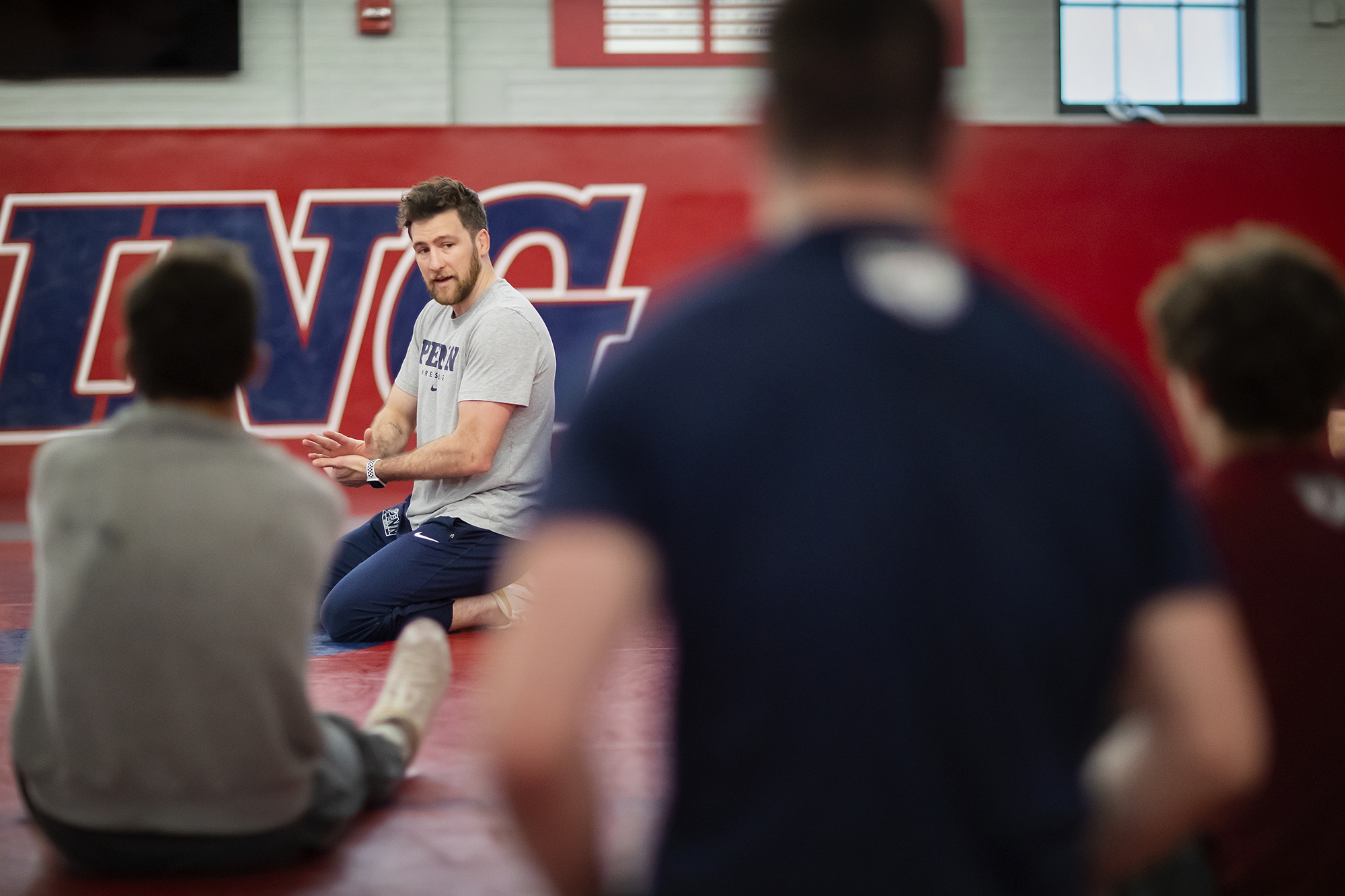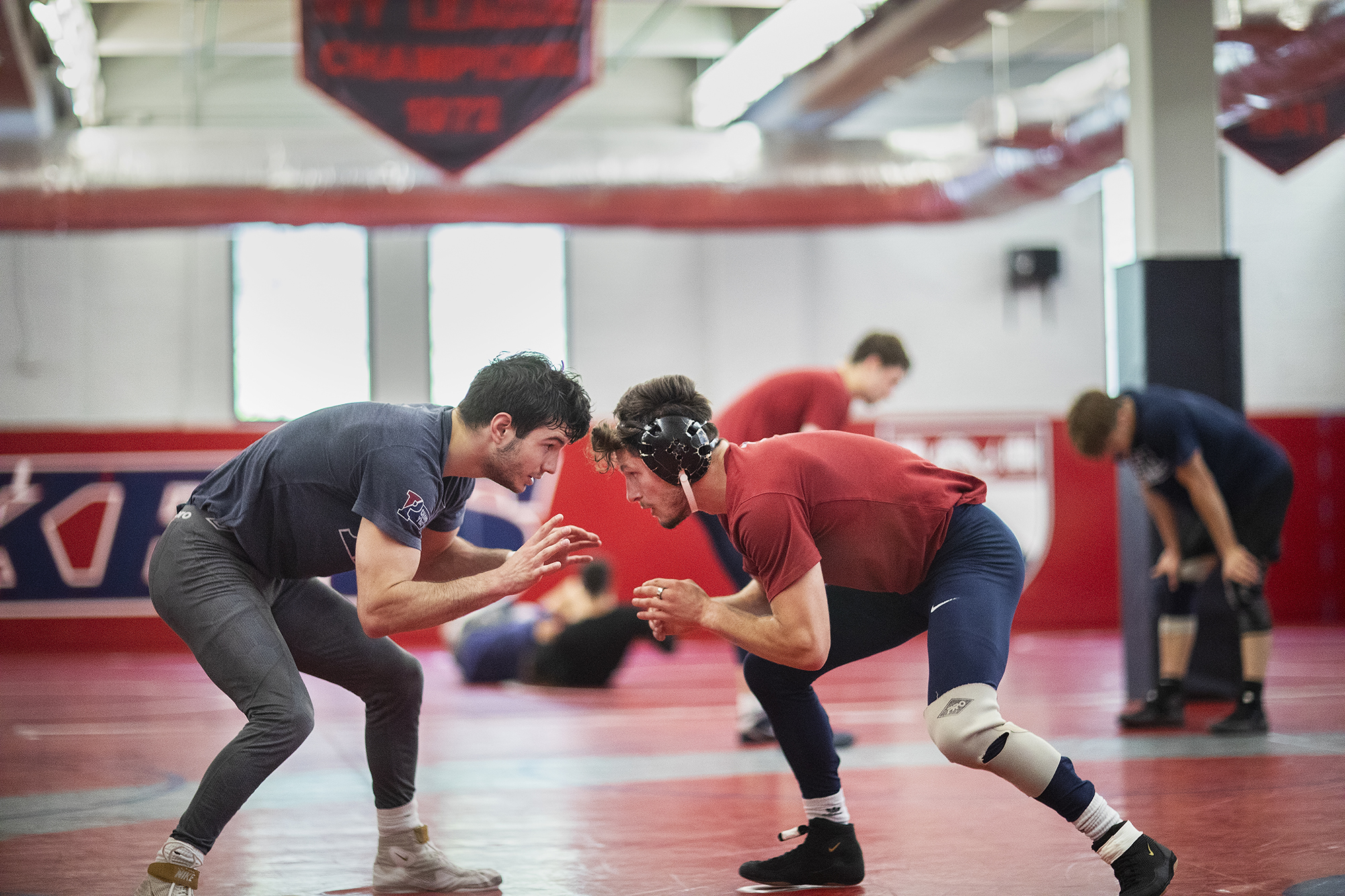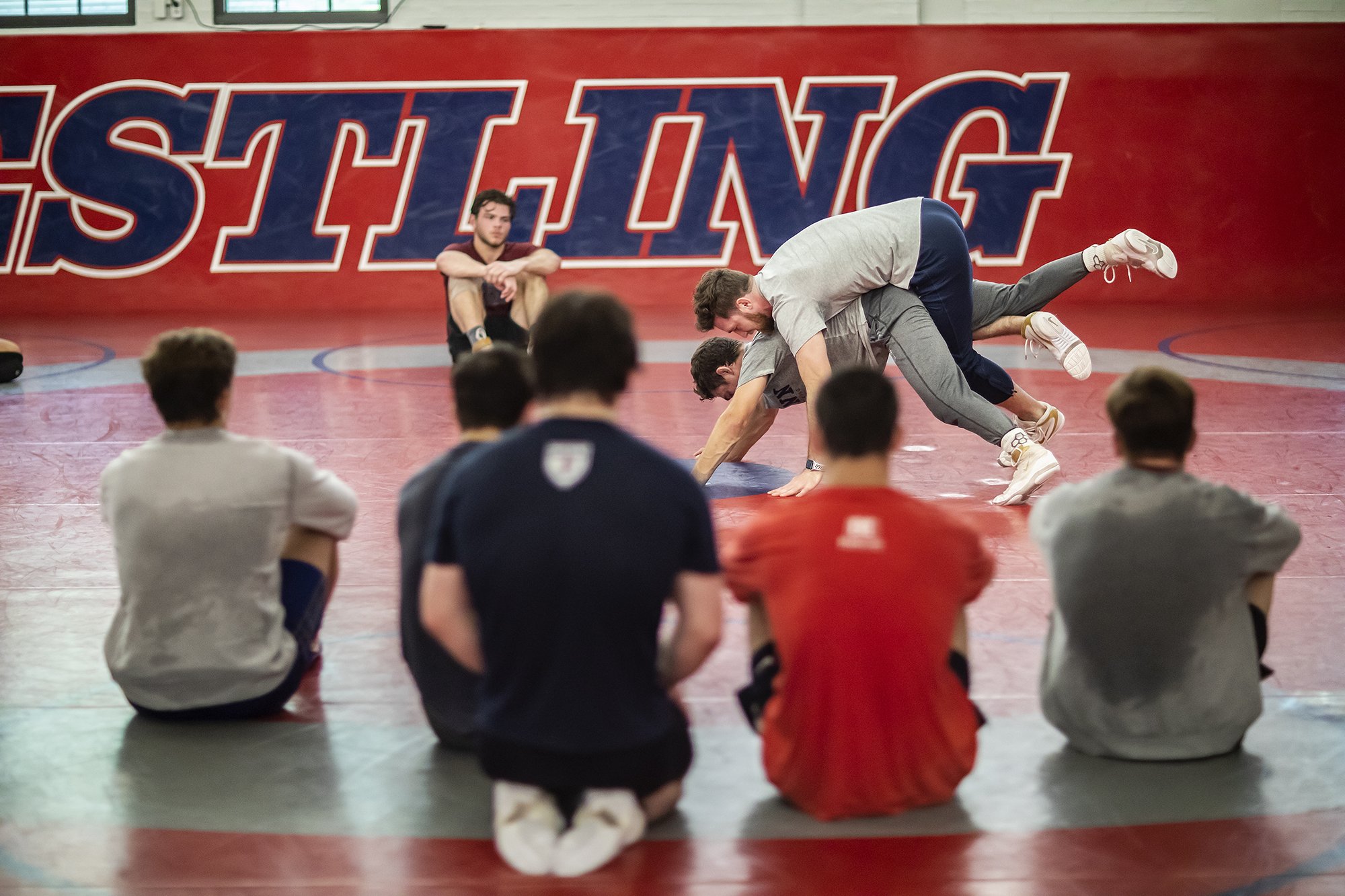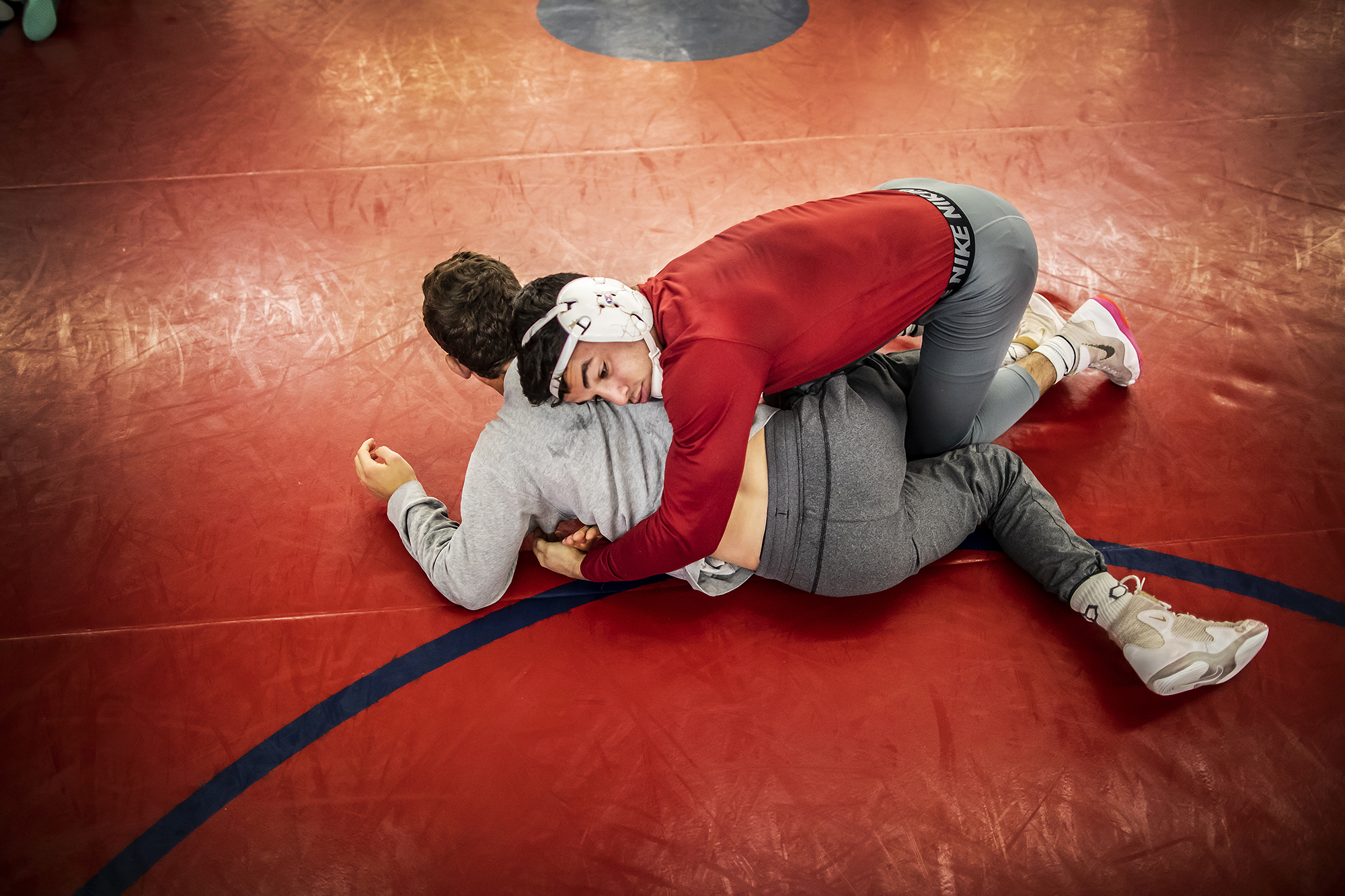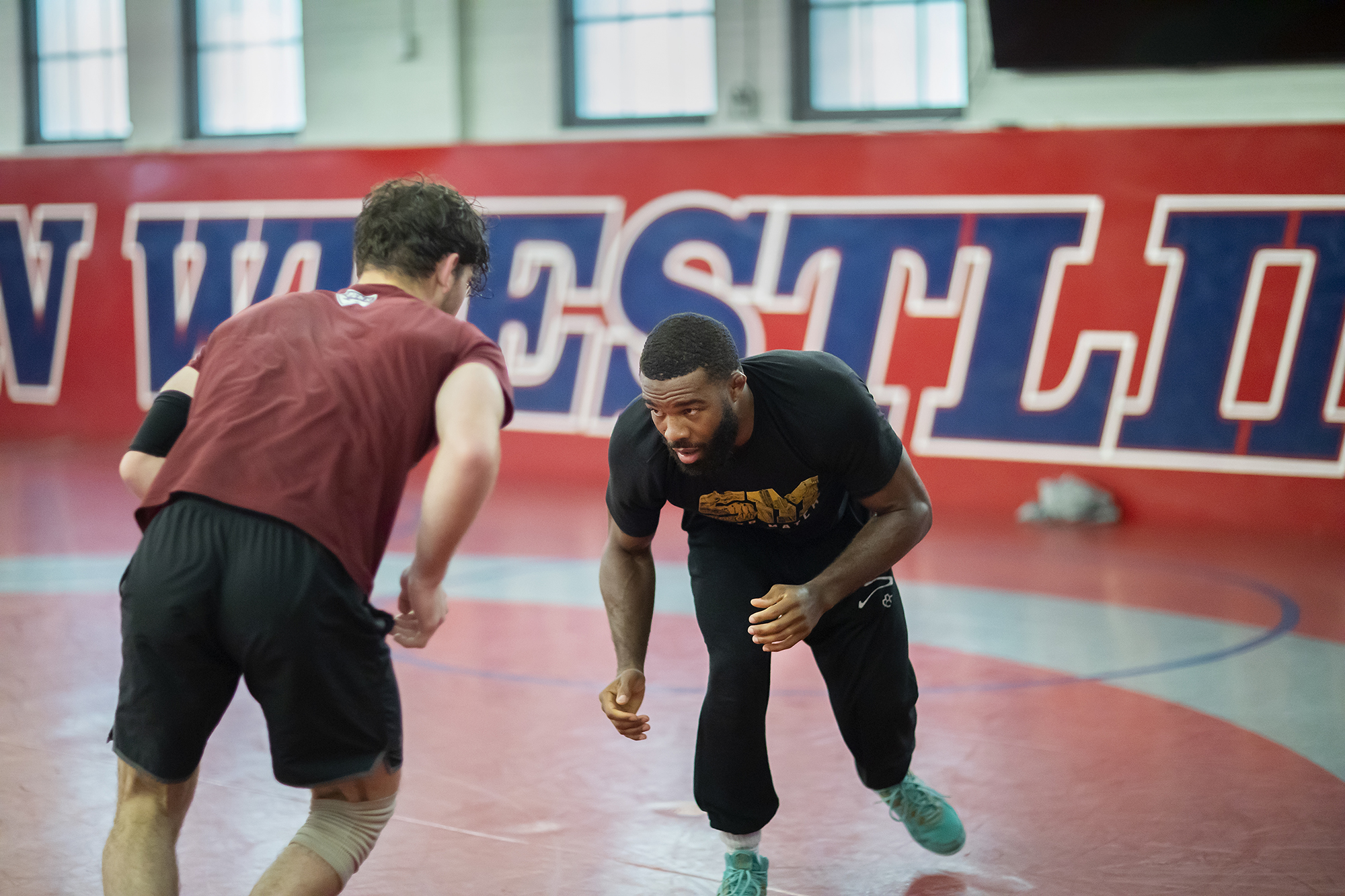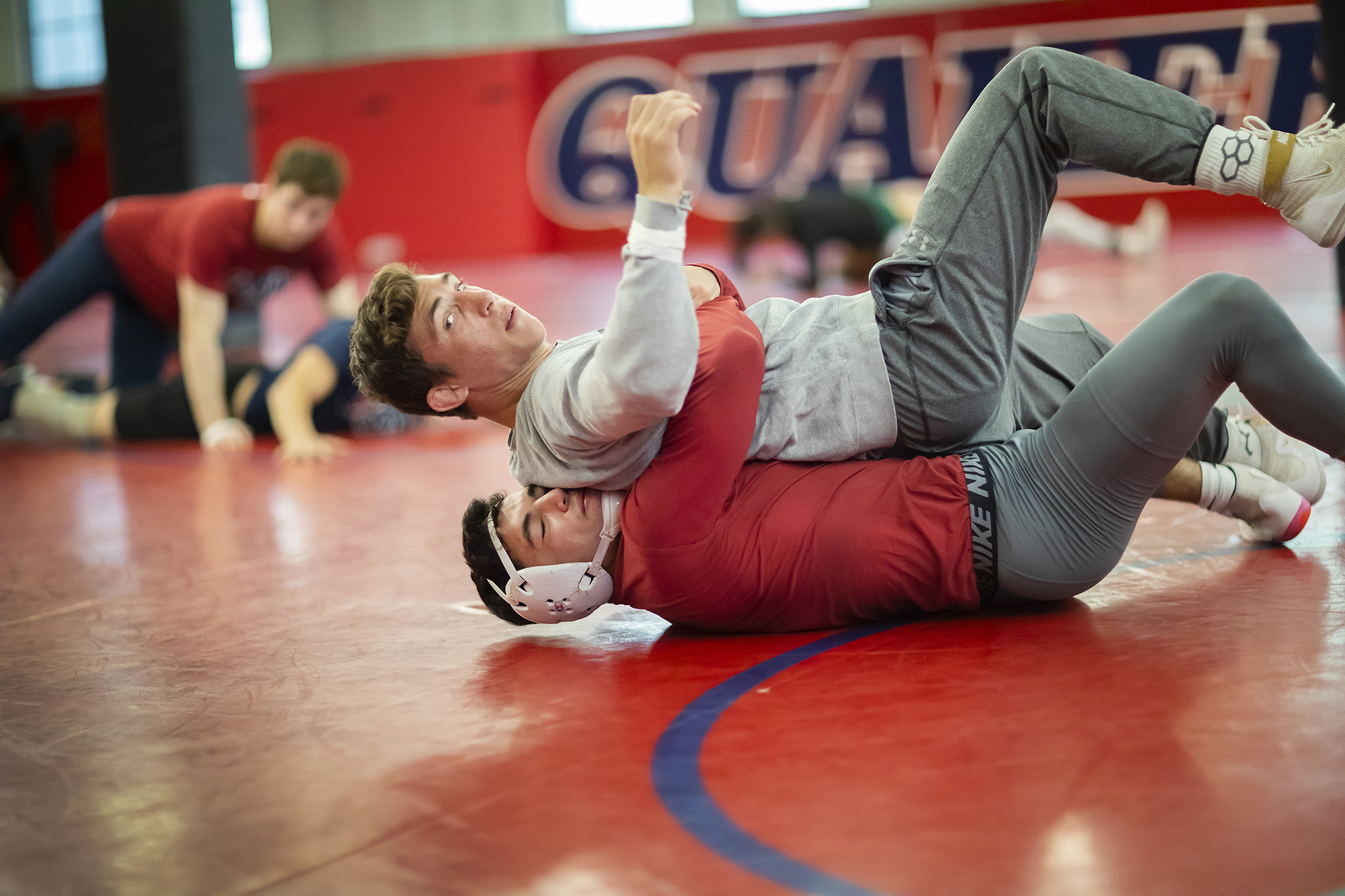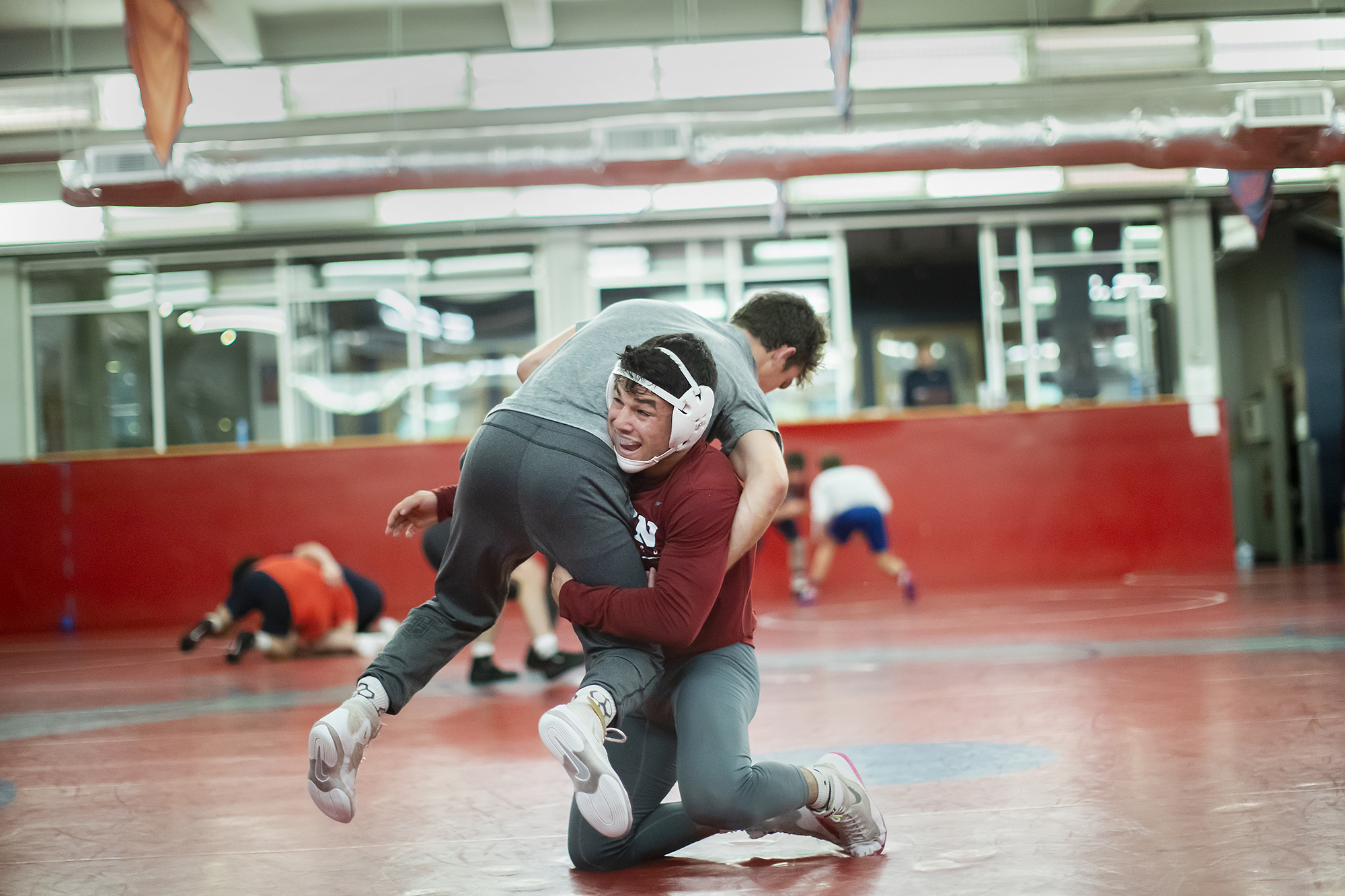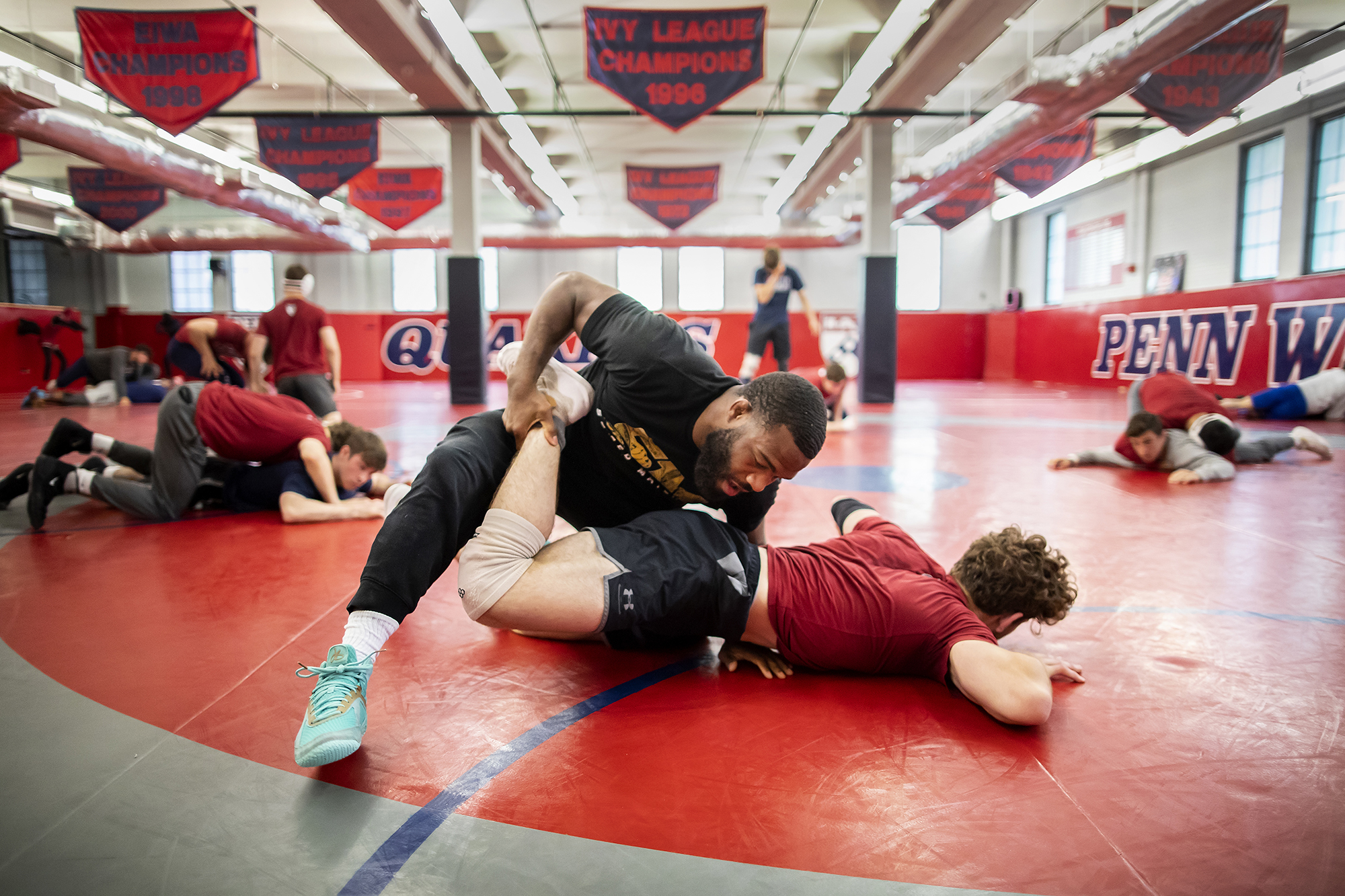
Carmen Ferrante is on his elbows and knees. Ferrante’s arms squeeze in a gut wrench around his opponent, hand locked around wrist at the softest part of the opponent’s stomach, beneath the ribs and above the hips. The opponent is using his hands, his hips, pressing and straining to keep his head and chest off the mat. His knees are already down. The opponent starts to walk his hands forward. His face is turning red; veins stand out in bas-relief.
A whistle blows and the athletes switch. This time it’s Ferrante on bottom, trying to avoid a wrist lock, trying to keep his face up.
“No lock is the goal! No lock is the goal!” shouts Bryan Pearsall, the Joshua J. Harris Wrestling Assistant Coach at Penn. He’s lithe, calm, levelheaded—a former Penn State wrestler not 10 years out of college, still young enough to demonstrate what he wants to see from his athletes on this Monday morning practice at the Pennsylvania Regional Training Center (PRTC).
“Where’s your head? Where’s your elbows?” he asks. “If my elbows start going, I’m going. Gotta hand walk,” Pearsall says. “Make it a strength contest. You gotta move.”
Founded in 2014 as a collaboration between Penn and Drexel, the Pennsylvania Regional Training Center, based at the Hutchinson Gymnasium, was among the first of this model—a nonprofit, satellite Olympic training center that serves Olympic-level athletes, college students, and the top high school wrestlers in a 250-mile radius. They also partner with Beat the Streets, a Philadelphia sports-based youth development program that provides training and mentoring opportunities.
The outreach is an integral part of their operation. “Serve others” is one of the PRTC’s core values, along with “struggle well,” “full effort,” and “faith over fear.”
‘Tradition, lineage, and pedigree’
“You create good men, they ultimately become good wrestlers,” says Jordan Burroughs, a five-time world champion and two-time Olympian from Sicklerville, New Jersey. Burroughs won gold at the 2012 Summer Olympics in London and aims to go to Paris for the 2024 Summer Games. He also serves as a one-on-one mentor for one of the Beat the Streets high school students.
Burroughs is 33 years old, with a wife and four children, all of whom he expects to wrestle. He’s thinking about legacy.
“Ultimately, as my career comes to an end, I want to be remembered as the most approachable wrestler ever, where anyone can talk to me, anyone could learn from me,” Burroughs says. “I never tried to big time anyone.” He says he has a civic duty to give back.
Burroughs coaches his sparring partner during practice. “When you push back,” he warns his opponent, “it gives me comfort, it gives me leverage,” he says. “When I have to chase you, it tires me out.” His partner nods. They reset, and begin again.
In wrestling, a pair starts from a neutral position in an athletic stance, feet under hips, bent knees, circling, getting a read on each other. They’re light; there’s an elegance to it. “Easy in, hard out,” Pearsall calls it. “You pick up your intensity when you get to a certain position.”
Being able to maintain the stance is vital, says Pearsall, “because a lot of times, you’re grabbing each other’s necks, you’re trying to pull each other down.”
Athletes get points for taking the other down. If one person can expose their opponent’s back toward the mat, they get points. Knees, elbows, and heads on the mat all garner points for the opponent. Wrestlers are all evenly matched by weight class, so each athlete is trying to leverage their own strength and skill.
Core strength is vital; it’s what keeps an athlete on their feet. PRTC athletes have four days of lifting and four days on the mat. Organized workouts total about 15 hours, but training can go on. Athletes work out on their own, and they watch tape. That’s important prep work for the next competition, to keep up to date on the newest techniques and to scope out their next opponent.
“Film informs how the next match might go,” says Pearsall. “If all the attacks come from the right, block them from the left. You want to go in with a strategy. Then relax into a flow state.” This refers to the “faith over fear” component. Train hard, then trust the training.
“You shouldn’t have any fear once you step on the mat,” says Ferrante, a rising senior from Newton, New Jersey, majoring in communication in the School of Arts & Sciences. “You want to go out there with a clear mind, not really thinking too much, just trusting your preparation that you’re ready to go.”
Matches are six minutes—two three-minute sections divided by a 30-second interval when opponents go back to their corners for coaching and water. In tournaments, those who win are wrestling two, three times a day.
“It’s a sport based on tradition, and on lineage and pedigree,” Burroughs says, “but it also is based on toughness and grit. And those characteristics are developed through struggle [in] hard times.”
At the end of a tournament, it looks “like I was just in a car crash,” says Michael Colaiocco of Spartan, New Jersey, a rising junior concentrating in finance and entrepreneurship at the Wharton School. “There’s just things that happen and you get dinged up, whether your eye splits or you tweak an elbow.”
During Colaiocco’s last tournament, he wrestled seven matches in two days. “I was just destroyed,” he says. Ferrante smiles. “But we’re young and we recover quick,” Colaiocco adds.
U23 World Team Trials
Colaiocco and Ferrante are two of the 18 athletes who drove out to Geneva, Ohio, on June 2 for the U23 World Team Trials. It’s three days of competition for those under the age of 23, with the end goal of making it to the World Team to represent the United States at the World Championship in Pontevedra, Spain, this October. The trials have 10 weight classes with just over 30 athletes competing in each.
There are two main styles of wrestling: freestyle and Greco-Roman, which primarily uses the upper body and doesn’t allow for leg attacks. To prep for the U23 trials, practices are freestyle-specific. The gut wrench, which Ferrante was employing earlier in practice, is one of the ways to get points in freestyle wrestling.
Another is leg laces—crossing an athletes’ ankles and rolling them, hopefully repeatedly. It’s two points for every roll and matches get called at a 10-point difference. “If you get in trouble there, the match could end really quickly,” Pearsall says. “Goal is keeping the knees as wide as possible. If I can keep my knees apart, they’re not going to turn me.”
If an athlete is on the mat, the referee will give their opponent 10 or 15 seconds to turn their opponent. Whatever happens, an athlete doesn’t stay on the mat forever.
“When you’re fighting the angle, you have to look where he’s trying to take you,” Pearsall tells the athletes. “Drive all your weight! Then you’re rolling; you’re rolling him.”
It’s a short, vital struggle, the only combat sport at the NCAA level. “I think there’s something about the manhood,” says Burroughs, “of being able to subdue someone else.”
Wrestlers tend to be “a ragtag, misfit group,” says Pearsall. “A lot of wrestlers get into it because they couldn’t make the basketball team or got cut from the football team, and wrestling is a sport that anybody can do. Doesn’t matter if you’re tall, short, big, small. It’s a sport that really can fit anybody.”
The sport doesn’t require a lot of fancy equipment either. The high-top shoes and uniform sweats are nice; the mats and padded walls make it more safe, but “think of how we all grew up: wrestling,” Burroughs says. “We first started wrestling with our dads and our brothers on the living room floor.”
“It’s a really diverse sport, a blue-collar sport,” says Pearsall. According to the National Wrestling Coaches Association, NCAA wrestling programs have the highest percentage of first-generation college students and are one of the most racially diverse sports as well.
For men, that is. Freestyle women’s wrestling was added to the Olympic Games in 2004, but college opportunities remain slim. There is no Division 1 women’s wrestling at any of the nine Ivy League schools, although Harvard, Columbia, and Princeton have club teams. Columbia and Princeton also have regional training centers that support female athletes.
For now, female athletes train at the PTRC during the Sunday developmental practices, but it’s a growth area, says Brandon Slay, executive director and head coach. He hopes to continue adding to the PRTC’s program and roster.
‘To struggle against an opposing force’
Originally from Amarillo, Texas, right in the panhandle, Slay is a 1998 Wharton alumnus who won gold during Australia’s 2000 Olympic Games. He named the oldest of his four children after the city that gave him glory: Sydney.
“I’m very passionate about the Olympic movement,” says Slay. “To be the best in the world—that passion flows through me. To be the executive director and the head coach of an Olympic Training Center here in West Philly, that happens to be headquartered at my alma mater, just makes it even better.”
Slay initially followed his Olympic win with a career as an itinerant motivational speaker. He’s driven, determined, and persuasive—the kind of person who carpes every diem. “There’s just a concept of waking up every day and believing in better,” he says. “Wrestling, I see it as really a worldview.”
“The word ‘to wrestle’ means to struggle against an opposing force. I want our guys to struggle well,” says Slay. “Whatever challenges are in my way, I want to struggle well through that. I don’t want to get pinned—but if I do, then I’m not going to quit; I’m not going to give up. I’m going to keep failing forward, because wrestling has taught me to do that.”
From coaches to students, all the PRTC-affiliates talk about what wrestling gave them, what wrestling taught them. If athletes make it to this level, the sport changes them, molds them into a better version of themselves, they say.
“I was the youngest of four,” says Burroughs. “A late bloomer, so I was pretty much the runt of the family. Wrestling made me everything that I wasn’t in real life. It made me strong and powerful. It gave me recognition and honor, but it also taught me how to operate with discipline and persistence and how to control my ego and walk the earth with humility.
“Everything that I am,” he says, “has been developed through and by wrestling.”
There’s a lot of discipline within the practice. There’s not a lot of chitchat, or banter. There’s no talking back. “Wrestling is probably one of the most structured sports that you’ll find,” Pearsall says. Everybody’s here to work.
The hardest thing about the sport is losing, Ferrante says. It’s a bitter pill for any competitor, but wrestlers learn that there are only so many things they can control. You can do all the right things for a long time, lose one match, and that’s it, he says. You’re out of the tournament and have to come to peace with that result.
“When you show up on match day, if you feel like you did everything in your power to prepare yourself as best as you could, then you can live with the result, win or lose,” Ferrante says. “If you do all the wrong things, you know, you got to accept that accountability.”
“You have a positive mindset,” Colaiocco adds. “And to know your why. Why you’re doing what you’re doing.”
Colaiocco, who believes that “there’s a little kid inside of everybody,” wants to make his 7-year-old-self proud, he says. That’s part of his integrity, his internal compass—his why.
“We’re getting started in 10 minutes,” Pearsall announces. It’s the last thirty minutes of practice, although practice goes over. Athletes are about to wrestle live. “Get your mind right,” he says. “Get your composure.”
The men readjust their knee brace, pull up a sock. The whistle blows again and the athletes are back on their feet, circling, ready to fight.




